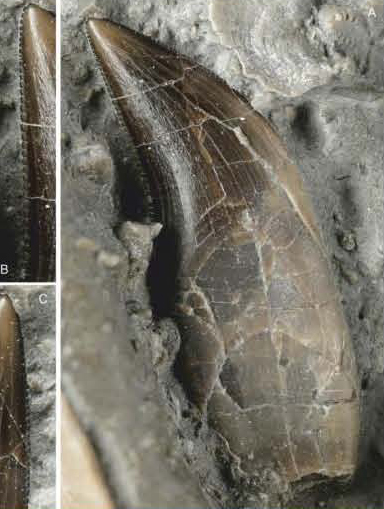Wales Gets a New Dinosaur – Dracoraptor
The Dragon Thief of Wales – Dracoraptor hanigani
The beautifully preserved meat-eating dinosaur fossil found at Lavernock Point (south Wales) has been formally named and described. Say hello to Dracoraptor hanigani, a two-metre-long predator whose fossilised remains were found by brothers Rob and Nick Hanigan. Reporting in the open-access on-line journal “PLOS One”, the fossilised material very probably represents the oldest known Jurassic dinosaur found to date in the British Isles.
Dracoraptor hanigani – An Agile Little Hunter
Picture credit: National Museum of Wales
To read more about this exciting fossil find: Welsh Dinosaurs – New Early Jurassic Theropod from South Wales.
“Dragon Thief”
The genus name means “dragon thief”, in honour of one of the national symbols of Wales, the species name honours the two fossil-hunting brothers who found it. This little hunter may only be distantly related to the “raptors”, but it does represent a significant fossil find, as dinosaurs are particularly rare in Lower Jurassic rocks. Dracoraptor, lived on an island archipelago, some 201.3 million years ago, plus or minus 200,000 years, the preserved bones and teeth (some 40% of the skeleton), have been so precisely dated in geological terms thanks to biostratigraphic dating of the strata.
The rock layers can be divided up into distinct zones (biozones) based on the characteristic fossils that layer contains. The dinosaur’s remains were found between two well-documented zonal layers. It was found above a conodont* zone (Chirodella verecunda), associated with the very end of the Triassic and below an ammonite zone Psiloceras planorbis, which is associated with the first faunal stage (Hettangian) of the Jurassic.
*Conodonts are an extinct group of tiny, jawless, marine animals that had mouths filled with several pairs of tooth-bars. They are believed to be related to early, jawless fish and probably superficially resembled eels. Their distinctive teeth, often found in abundance, provide very useful “markers” in rocks, helping palaeontologists to date the relative ages of different rock layers. Conodonts became extinct at the end of the Triassic.
Helping to Understand the Early Diversity of the Dinosauria
The fossil, collected from a cliff fall at Lavernock Point, has had a charmed life. Firstly, the fossil was found in marine sediments, apparently, the carcase of this little dinosaur was washed out to sea and settled on the sea floor. Sea urchins crawled over it and most likely fed on the rotting flesh, some of these sea urchins have been preserved in the surrounding rock matrix.
Currents did not disturb the bones. This explains why the specimen is so complete. In addition, if Rob and Nick Hanigan had not chanced upon the specimen, the fossils would have been washed out to sea and lost forever in just a few days.
Dracoraptor hanigani
Furthermore, Everything Dinosaur reported on the serendipitous discovery of more of the specimen, by third year palaeontology student Sam Davies, who coincidently is tutored by one of the authors of the PLOS One paper, Dr David Martill (School of Earth and Environmental Sciences, University of Portsmouth).
To read more about Sam’s lucky find: Lucky Find Puts Welsh Dinosaur on a Firm Footing.
Views of One of the Teeth Associated with the Specimen (Presumed to be from the Upper Jaw)
Picture credit: PLOS One
Explaining the significance of this fossil discovery, co-author of the paper Steven Vidovic (PhD Researcher at Portsmouth University), commented:
“It’s right at that point in the diversification of dinosaurs where so-called theropod dinosaurs, the meat-eating ones, became what are called neotheropods. It’s from this moment onwards that they go on to become all the forms we know, like T. rex, Velociraptor and even birds.”
Very Rare Fossil Find
Early Jurassic dinosaur fossils are extremely rare and this particular specimen, which may represent an immature adult, is very important as it provides data on the evolution of meat-eating dinosaurs so soon after the Triassic/Jurassic extinction event. Dracoraptor hanigani is the first dinosaur to be described from the Jurassic of Wales. It probably lived on a small island (part of St David’s Archipelago), or perhaps its corpse had been washed out sea from the nearby, larger land mass known as the Welsh Massif. It is one of very few early theropod remains found in Europe.
The Palaeogeography of the Early Jurassic (Europe – Hettangian)
Picture credit: PLOS One
The picture above show the palaeogeography of western Europe, approximately 200 million years ago. Modern western Europe has been superimposed to provide a reference. The numbers in the small, yellow circles record the location of other early theropod or neotheropod discoveries:
- Isle of Skye
- Barrow upon Soar (Leicestershire)
- Wilmcote (Warwickshire)
- Lavernock Point – the location of the Dracoraptor find
- Dorset
- Airel (France)
- Brouch (Luxembourg)
Everything Dinosaur stocks a variety of theropod models and figures: Dinosaur and Prehistoric Animal Figures.
A cladistic analysis suggests that Dracoraptor was a basal neotheropod. It may have been related to Tawa hallae and Daemonosaurus chauliodus ( both from the Ghost Ranch location, New Mexico, United States). Everything Dinosaur has written about the discovery of both Tawa and Daemonosauru. For further information on these fast-running little predators, see the links below.
To read more about Tawa: New Theropoda Dinosaur Discovery Sheds Light on Dinosaur Diversification.
To read more about Daemonosaurus: Little Demon from the Dawn of the Dinosaurs.




